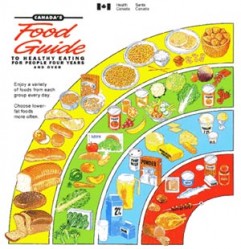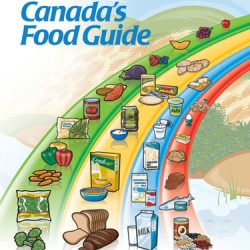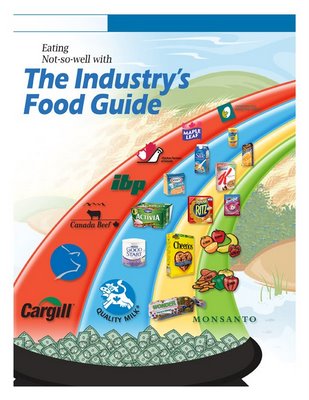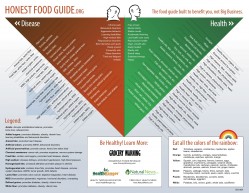Government-based food recommendations in the forms of various guides are what many people look to in order to know how to feed themselves and their families. However, as the past several decades since these guides came out have shown, all too often they leave many people more confused and unhealthy than ever. In this essay, we will explore the history and nature of such guides and why eating according to a food guide may actually do more harm than good.
Probably since your early grade school days, you can remember being shown those colorful charts that represent your nation’s version of a food guide. A food guide is supposed to give us the basic foundation and guidelines of what to eat, to achieve the nutritional needs for our body’s optimal state of health. Food guides differ sometimes slightly, and sometimes majorly between different countries. Over the years however, one thing that they have held in common is that they have become a popular tool that is referenced by many nutritionists, dietitians, doctors, and teachers alike, when it comes to teaching people how to eat for supposed health.
Despite their wide acceptance however, a closer examination of food guides shows a whole different story. In fact, critics of food guides over the years are not shy to voice their concerns about how misleading most food guides actually are when it comes to shaping people’s health.
History of The Food Guides
United States Food Guides
The history of the American food guide began in 1916, after some major discoveries in the areas of vitamins and other nutrients. This is when the USDA developed the first 5 food groups: (vegetables & fruits), (meat, fish & milk), (cereals), (simple sweets) and (butter & wholesome fats). At this point there was little concern about the harmful effects of overnutrition. As long as one ate the minimum requirements, one could eat anything they liked.
The first RDA’s (recommended dietary allowances) were announced in 1941, and this lead to several new food guides being developed, with an emphasis during the next 15 years on the nation’s food supply and link to the wars. By 1956, a general 4 food group guide was developed. In 1979, the Daily Food Guide was developed, which expanded on those 4 groups, both in terms of increasing servings and adding in sweets, fats and alcohol.
In 1992, there was the emergence of the Food Guide Pyramid, after many criticisms of the previous guides, and this was the first one to put more emphasis on plant material, although meat and dairy were still greatly overemphasized.
In 2005, the My Pyramid was introduced. This version still emphasized the various food groups, however it broadened them even further, where it even included oils as a food group. (Something we know today should be limited, if not altogether avoided, not promoted as something to add to one’s diet.) It tried to put more emphasis on physical activity, though as our weight stats have shown over the past few years, this hasn’t been widely put into practice by any means.
Finally, the latest edition came out in 2011. This was the greatly simplified guide called My Plate. While the simplification may have been a step in the right direction, the food groups that are presented on the plate, which is to resemble what we should be eating for our meals is a sad story. There is still a blatant push for the consumption of dairy, which is one of the most destructive foods to our health and weight, as leading edge science (and the basics of nature) have shown time and time again. Secondly, there is a section on the plate called “protein” leading people to the erroneous conclusion that there is actually a food out there that is pure protein. Protein is in every food on the planet, be in plant or animal. It is only not present in pure fat, like oils, and pure sugar sources. And when it comes to animal products, most are higher in fat than protein, or equivalent in these two making it silly to consider animal foods as the protein. They can all too often just as easily be the “fat”. So as things go, it appears over the years that as one thing is fixed, a new problem or area of confusion or misinformation is introduced.
Canadian Food Guides
In Canada, the first official food guide was introduced in 1942. Over the years, changes were similar to that of the United States, however the focus always revolved around the four major food groups. Most Canadians are still familiar with the popular version of the food guide from 1992, which grossly misrepresented the importance of the grain group. The newest food guide to come out in Canada was in 2007, and some major beneficial changes were made. Fruits and vegetables, now became the most important group, and their servings were increased. However, it still remained a limited, basic 4 food group guide. Here is the 1992 guide compared with the 2007 guide.
1992
2007
Limitations Of The Food Guides
Over the years many criticisms were put forth about the food guides.
One of the main criticisms as I already mentioned, has been the huge overemphasis of meat and dairy. In fact a general consensus exists, that the food guides are too influenced by those industries. Many groups have even flat out accused the USDA of being biased towards them, due to the strong ties between them. This is no surprise as the government lobbies are also in great favor of promoting the meat and dairy industries, with links to having a healthy economy. We know today, that meat and dairy carry each with them numerous health problems and should in no way, be eaten in the amounts that are recommended. For some fun from a political side, check out the following food guide:

Another major criticism was that the food guides have not kept up adequately with nutritional science. Today, we know that there is so much more to the benefit of plant food, than just simple vitamins and minerals. We also know that meat and dairy are not requirements for a healthy diet. We know that refined grains and sugars are detrimental to our health, and should not be promoted on food guides that are supposed to teach people how to eat and be healthy.
Another area of concern was that throughout most of the food guides, grain servings have been grossly overstated. Grains were made to be eaten in the largest amounts of all the foods, with numbers ranging from 5 – 11 servings of grains per day. This is too much for most active people, never mind sedentary people. Hence the food guides were also blamed for contributing to the obesity epidemic we have today. Grains are very dense in energy, and you just cannot eat like that regardless of whether they are whole or processed, white grain products.
Although the food guides try to be simple and use various colors, pictures and charts, surveys show that despite all this, most people still have no idea how to use them and hence eat healthy. Problems arise around how much actually is a serving, how to fit all the servings into a day, etc. In the end, many people are often left more confused and stuck in counting numbers, rather than making and eating food, simple and fun.
Finally, the food guides do not cater to many people in the population. The food guides are not applicable to people with various conditions, especially diabetes. They can somewhat be useful to vegetarians, but are completely useless to vegans.
Bottom line, the food guides mislead people into thinking that they must have meat, dairy and grains to be eating a so called healthy diet. When in reality, major populations of people around the world today, eliminate one or more of these food items and function completely well.
Optimal Health and Eating Beyond The Food Guides
As a holistic nutritionist and optimal health expert, I first want to dispel the myth that ALL nutritionists, and even dietitians, work based on the general food guides or government-based, health organization’s recommendations. Yes, dietitians are most prone to offering nutrition advice based on these guides, nutritionists less so, and holistic nutritionists even more less so. Many experts from each of the mentioned areas, myself included, teach and practice based on leading edge nutritional science, not industry-influenced propaganda.
The first thing I always share with people is: take accountability for your own health! We have so much information at our finger tips today, thanks to the Internet, that while some sources may not be the most credible, there are enough good sources to be able to draw upon for best advice. Ultimately, you cannot lose your own common sense or internal guidance system. You need to listen to your body and follow in intelligent and conscious ways based on what may be best for you.
Secondly, what we know today about nutrition, versus what your parents knew, versus what your grandparents knew has changed astoundingly! This is why it is also important to be open-minded, ask questions, grow and keep learning. Don’t fall for blind faith or ideas conditioned by the industries that want to sell their products.
Thirdly, not everyone is the same. While we, as human beings, all require generally speaking the same foundation for optimal health—whole-food and highly plant-centered—our unique biochemical, physical, and geographical differences will dictate slightly different approaches. Some people thrive better on a higher vegetable diet, while others thrive better on a higher grain diet, etc. So there is no way that any one chart can tell us accurately what is right for us all.
You Are the Solution
The first rule of eating is that it should not be complicated. Look at nature: every single animal knows how to feed itself and thrive in its weight, health, and adaptability. What about us? What happened to the human animal, who is still considered by many to be the most intelligent?
The truth is that we don’t need charts or calculators or fancy software to figure out what we should be eating. We don’t need a nutrition degree to know that processed and refined food is not part of a healthy diet. Look and see past the illusions, the fancy and clever marketing, and the constant noise from media outlets, retailers, and even many experts who are all promoting their own agendas. Let your common sense prevail. Simply look at mother nature and eat a variety of what she offers in its most natural form.
You do not need to count calories or wonder if you got enough protein. Rather, eat enough, real, whole food from a variety of sources, mostly plants and enjoy your life. We know today, that the healthiest foods for us are ones that are most natural and plant-based. This means: fruits, vegetables, beans, legumes, grains, nuts, and seeds. But NOT these foods in their processed or refined forms. When it comes to animal products the story gets a little more complicated; unless you are sourcing wild (not factory-farmed) animal products in their most natural and organic forms, you are not doing your health any favors by ingesting them. Likewise, if they are present, they still must be kept to a minimum for optimal health (physical, mental, emotional) and weight.
Numerous reports, studies, doctors, films, and books have been showing consistently for the past few decades that animal products, next to all processed foods, are amongst the biggest reasons for our current weight, cancer, and heart disease problems. Of course these are all too often counteracted by the heavily ingrained food guide recommendations and heavy marketing by the meat and dairy industries to make sure we live in fear that without milk, our bones will break and without meat we just won’t get enough protein.
Concluding Guidance
A discussion like this one is far from over with this one article, if anything it is just the beginning for so many of you. So be sure to keep growing and learning to create a foundation for optimal nutrition and health that is not the latest fad or economically-sponsored initiative. Seek quality, leading edge information and simply, simply, simplify!
For the time being, I leave you with 5 very simple and general guidelines for optimal eating:
- A major portion of any and every meal should be vegetables, especially green, leafy ones.
- Whole grains should be real, and not refined in any way. They should be added to your meals as is most appropriate for your personal age, health, weight, and physical activity needs.
- Eat a generous amount of beans with at least one meal each day.
- Your plates should always display a rich variety of natural colors.
- Fruits, nuts, and/or seeds make great snacks throughout the day.
To add to this, I leave you with one other, very valuable resource. There was one food guide that I came across in my research that I do support as a good reference. It is called the Honest Food Guide and it was developed by Mike Adams of NaturalNews.com.
It is not perfect either, but I highly recommend this food guide because instead of telling you what to eat, it gives you the facts and leaves you with a choice of what state of health you desire. It does this by presenting you with two areas of food choices and lets you decide which ones you want to choose from. On the left side, are foods that lead to health problems, and on the right side are foods that lead to optimal health. Click on the picture below, to download your own copy of it for reference or printing.
Most importantly, get creative with natural food combinations, have fun and enjoy! For more information, check out the many other articles and recipes on this site that promote a simplified approach to eating that is as practical and delicious, as it is healthy.
References
Nutrition for Health, Fitness & Sport by Melvin H. Williams
The Dietitian’s Guide to Vegetarian Diets: Issues and Applications by Virginia Messina et al.
Becoming Vegetarian: The Complete Guide to Adopting a Healthy Vegetarian Diet by Vesanto Melina et al.
The China Study: The Most Comprehensive Study of Nutrition Ever Conducted And the Startling Implications for Diet, Weight Loss, And Long-term Health by Colin T. Campbell et al.
The Food Pyramid: Its History, Purpose and Effectiveness by Jaye Lewis
Understanding Protein in Plant Foods by Evita Ochel
8 Protein Myths About Plant and Animal Protein Sources by Evita Ochel

